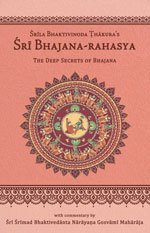Bhajana-Rahasya
by Srila Bhaktivinoda Thakura Mahasaya | 2010 | 123,965 words
The Bhajana-rahasya Text 21, English translation, including commentary (vritti). The Bhajana-rahasya is a compilation of verses describing the mercy of the eight pairs of names (Yugala-nama) of the Maha-mantra. This is text 21 belonging to the chapter “Shashtha-yama-sadhana (Sayam-kaliya-bhajana–bhava)” representing six dandas after dusk: approximately 6.00 p.m.–8.30 p.m.
Text 21
The mood of absolute opulence assuming the form of sweetness (mādhurya) is described in Śrīmad-Bhāgavatam (3.2.21):
स्वयन्त्व् असाम्यातिशयस् त्र्यधीशः स्वाराज्य-लक्ष्म्य्-आप्त-समस्त-कामः
बलिं हरद्भिश् चिर-लोक-पालैः किरीट-कोटीडित-पाद-पीठःsvayantv asāmyātiśayas tryadhīśaḥ svārājya-lakṣmy-āpta-samasta-kāmaḥ
baliṃ haradbhiś cira-loka-pālaiḥ kirīṭa-koṭīḍita-pāda-pīṭhaḥŚrī Kṛṣṇa is Himself the Supreme Lord of the three potencies (sandhinī, saṃvit and hlādinī). No one is equal to Him, so who can be greater than Him? All of His desires are fulfilled by His own transcendental goddess of fortune. Indra and innumerable other loka-pālas, deities presiding over different regions of the universe, bring Him varieties of offerings and pay their obeisances, touching the tops of their crowns to the footstool on which He rests His lotus feet.
समाधिक-शून्य कृष्ण त्रि-शक्ति-ईश्वर
स्वरूप-ऐश्वर्ये पूर्ण-काम निरन्तरsamādhika-śūnya kṛṣṇa tri-śakti-īśvara
svarūpa-aiśvarye pūrṇa-kāma nirantaraसोपायन-लोकपाल-किरीट-निश्चय
लग्न-पाद-पीठ स्तवनीय अतिशयsopāyana-lokapāla-kirīṭa-niścaya
lagna-pāda-pīṭha stavanīya atiśaya
Commentary: Bhajana-rahasya-vṛtti:
The general meaning of the word tryadhīśvara is that Śrī Kṛṣṇa has innumerable forms and incarnations. He has unsurpassed opulence. Brahmā, Viṣṇu and Mahādeva are the lords of creation, but they are under the rule of Śrī Kṛṣṇa, who is the Supreme Lord (adhīśvara) of everyone.
The intermediate meaning of tryadhīśvara is that the three puruṣaavatāras–Kāraṇodakaśāyī, Garbhodakaśāyī and Kṣīrodakaśāyī–are the partial expansions of Śrī Kṛṣṇa’s expansion, Baladeva Prabhu. This means that Śrī Kṛṣṇa is the Supreme Lord of them all.
The essential meaning of tryadhīśvara is as follows. In the scriptures, Śrī Kṛṣṇa is known to have three places of residence. One place is His inner quarters, Goloka Vṛndāvana, where He is eternally present with His mother, father, friends and beloveds. There Yogamāyā serves Him as a maidservant. Beneath this Goloka-dhāma is Paravyoma, also known as Viṣṇuloka. Śrī Kṛṣṇa’s vilāsa-mūrti, Śrī Nārāyaṇa, and unlimited other forms reside there. This is Kṛṣṇa’s intermediate place of residence. Below this Paravyoma is Śrī Kṛṣṇa’s third place of residence, called bāhyāvāsa, His external residence. It is situated in the material realm, across the Virajā River where countless universes are present like separate chambers. This place is also called Devī-dhāma, or Māyā-devī’s realm, and the living entities who are bound by māyā reside there. The material energ y (jagatlakṣmī), the shadow of the transcendental goddess of fortune (rājyalakṣmī), protects the wealth of this world.
Śrī Kṛṣṇa is the Supreme Lord of these three places–Goloka, Paravyoma and the material universes. Both Goloka and Paravyoma are transcendental and are the divine opulence (vibhūti) of the citśakti. They are therefore called tripāda-aiśvarya, the opulence comprising three-quarters of the Lord’s energy. The vibhūti of māyā, the material universe, is called ekapāda-aiśvarya. The opulence in Śrī Kṛṣṇa’s transcendental dhāmas is three times that of the material world. His tripāda-vibhūti (the spiritual world) cannot be glorified in words. In the unlimited universes of the ekapāda-vibhūti, there are countless Brahmās and Śivas, and they are called loka-pālas, eternal maintainers of the order of creation.
Once in Dvārakā, Brahmā came for Śrī Kṛṣṇa’s darśana. When the doorman went to inform the Lord that Brahmā had come to meet with Him, Śrī Kṛṣṇa asked, “Which Brahmā has come? What is his name? Go and ask him.” The door-keeper went back and enquired accordingly. Brahmā became astonished and said, “Please go and tell Him that the father of the four Kumāras, Caturmukha Brahmā, has come.”
When Brahmā reached the threshold of the Sudharmā assembly hall, he became stunned. The crowd was such that he could not enter. Millions and millions of Indras, Brahmās, Śivas and other loka-pālas, each with heads numbering from eight to thousands, were paying their prostrated obeisances in front of Śrī Kṛṣṇa’s footstool. When their crowns, which were inlaid with jewels, touched the ground, loud clattering sounds arose and mixed with sounds of the loka-pālas’ jaya-dhvani (calls of victory), which resounded in all directions. Caturmukha Brahmā was like a firef ly in the midst of millions of suns. Suddenly everything disappeared and the dumbfounded Caturmukha Brahmā stood alone. He was astonished to see this magnificent opulence of Śrī Kṛṣṇa, and his pride vanished. Ashamed of his offence, he began to glorify the Lord, praying for forgiveness. Thereafter, Śrī Kṛṣṇa sent Brahmā on his way.
Tryadhīśvara has another confidential meaning. The word tri refers to Śrī Kṛṣṇa’s three abodes–Gokula, Mathurā and Dvārakā. Another name for these abodes is Goloka. Śrī Kṛṣṇa is naturally and eternally present in these three abodes, and He Himself is their adhīśvara (Supreme Lord). Therefore, He is called tryadhīśvara. The dik-pālas, who preside over the ten directions of the globe of the unlimited material universes, as well as all the cira-loka-pālas who reside in the coverings of the unlimited Vaikuṇṭhas, were paying their daṇḍavat-praṇāmas at Śrī Kṛṣṇa’s footstool.
Svārājya-lakṣmy-āpta-samasta-kāmaḥ–Svarājya-lakṣmī, the transcendental goddess of fortune, fulfils all Śrī Kṛṣṇa’s desires. He has unlimited pastimes in Vaikuṇṭha and other abodes, but amongst them all, His human-like pastimes (nara-līlā) are topmost. In His inner quarters of Śrī Goloka Vṛndāvana, His opulence (aiśvarya ), being adorned with sweetness (mādhurya), is billions of times greater than His opulence in Vaikuṇṭha.
